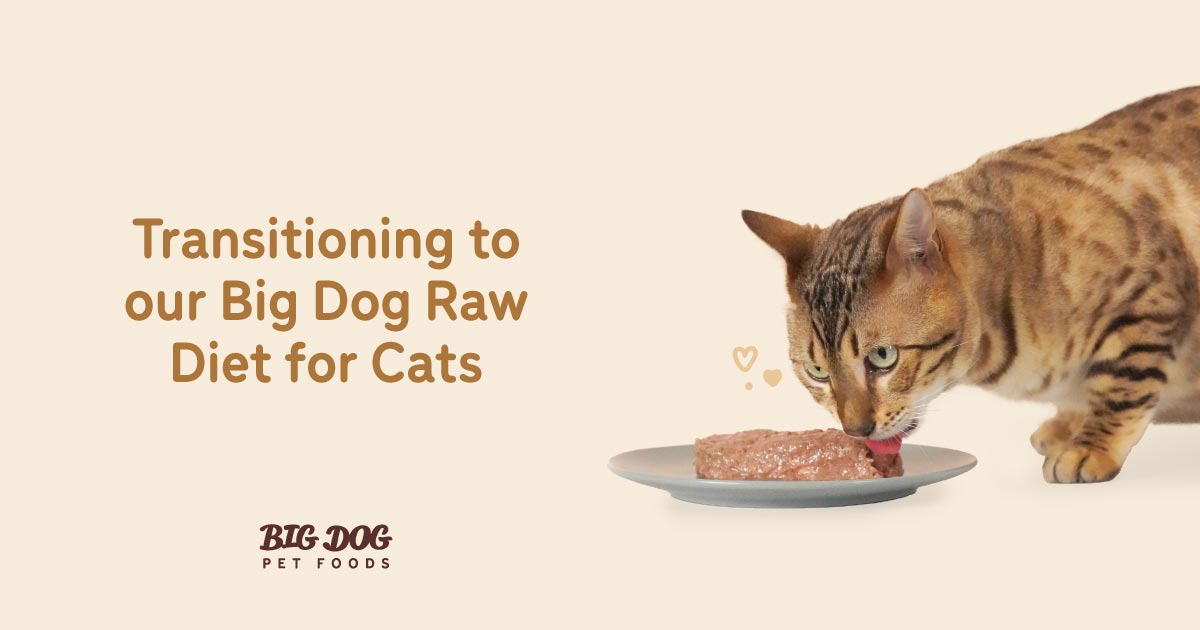Transitioning to our Big Dog Raw Diet for Cats

Introduce your cat to a raw food diet
Feeding Behaviour

We all know cats can be fussy… but do you know why? When thinking about changing your cat’s diet, it’s important to understand the science behind the way your cat’s brain works. Cats do what is known as “imprinting” on their food, as kittens they pick up on specific smells, shapes and textures to determine what is and isn’t food.
Imprint eating is of great value for the wild cat, distinguishing the difference between a meal and dangerous plant or object is definitely an evolutionary advantage, but this can cause dietary behavioural problems for the average domesticated cat.
Cats are also genetically designed to crave foods high in fats and salts. Kibble companies know this and develop their foods with this in mind. Another thing to note about cat psychology is their addictive tendencies, cats can become addicted to the taste, smell, texture and even the shapes of their food.
With all this in mind, you can begin to see how transitioning a cat from kibble to raw may be a challenge. Because they have preferences for certain smells, shapes and textures of foods, we need to feed them with these things in mind. Your cat isn’t being “fussy” this is just how its brain is wired, so you might need some tips and tricks for getting your cat to eat raw food, which is where we come in!
If the idea of feeding a species appropriate diet appeals to you and you’re wanting to make the transition from a kibble diet to our Big Dog Raw Food for Cats, keep on reading.
The Transition
The transition from kibble to raw can be long and challenging, we recommend a very slow transition. The reason for this is to avoid upset stomachs but primarily because rejection of the food is to be expected. Give your cat the time and space they need to figure out their new diet. That being said, you do not want to leave it for more than 24 hours without eating something. Cats need to eat frequently as fasting is unnatural to them and could induce a case of Hepatic Lipidosis (feline liver disease).
There are three steps to the transition from kibble to raw, you’ll need to transition from kibble to canned food to then raw.
Remove the grazing table

If your cat is an all-day dry food grazer, you’ll need to create an eating schedule for them. This is how we will create pockets of hunger which ultimately will lead into eating their new diet. Split the kibble into 3 meals a day and feed for a week or two, depending on how opposed to the idea your cat is. This removes the grazing habit and gets them use to portion control.
Kibble to Canned

Once your cat is use to eating three dry meals a day, replace one of the meals with a canned meal. The two portions of dry a day will be enough to supply the body with enough nutrients and avoid liver disease, but will also leave the cat feeling hungry and more inclined to eat the wet food. You’ll need to repeat this process until the cat is eating the canned food for three meals. It is important to try find a good quality canned food as this will be their main source of nutrients for a little bit during the transition. Keep in mind this transition could take weeks to months.
Canned to Raw

Transitioning a cat from kibble to canned is the most challenging part as it’s a whole new consistency. When changing your cat to a raw diet from canned you’ll want to start with 10% raw and the rest canned. Every cat is going to react to this change differently, some cats prefer it mixed in where they can’t even tell, others would prefer their new and old food side by side so they can sus it out a bit better. Once your cat has eaten that portion of raw you can add another 10% and so on, you’ll only add more once your cat has eaten the whole portion, this again could take weeks to months.
Note: It is easier to introduce kittens to a raw diet, the sooner you do it the better, you don’t want to give them time to develop any addictions to kibble. You can start the on a raw diet straight away but if they reject it, do not starve them, feed something that appeals to them and transition from there. For more advice on introducing a raw food diet to kittens, head here.
So we know we need transition very slowly according to our transition guide to accommodate for smell, shape, texture and addictions but where do we go from here? We’ve got some tips and tricks for getting cats to eat raw food!
Feeding Tips

Feeding Location- Cats will generally eat better when they feel comfortable, safe and relaxed. Coming from being solitary hunters, they prefer to take their time with their food, they like to sit and graze as they please. It’s important to keep feeding time as stress-free as possible. In contrast, dogs being pack-hunters means they tend to gobble their food down, as if competing with each other. If feeding around another pet, like a dog, it might be a good idea to feed your cat somewhere the dog can’t reach and disturb them, for example the kitchen bench or a completely different room. When changing your cat to a raw diet, feeding them in a new area that they don't associate with their old diet can encourage them to try their new food.
Bowl - Bowl shape and height can be another reason your cat may be cautious to eat. Cats tend to prefer shallow bowls or even plates as they have extremely sensitive to the touch whiskers. Your cat may experience 'whisker fatigue' if their whiskers are touching the edges of their bowl, this can be painful to them and stop them from eating. The average cat prefers to eat out of a clean bowl (fair enough, so do I), so make sure you’re cleaning the bowl after each meal, soaking in hot water is perfect. This not only keeps your cat happy and eating, but it destroys any leftover bacteria in the bowl.
Temperature and Aroma- After thawing your Big Dog for Cats patty in the fridge, it’s still going to be cold. As cats are hunters they prefer their food to be room temperature or body temperature (their prey). To safely warm it up, put the sealed patty in a sink of hot water for 5-10 minutes to bring it up to room temperature. Ensuring not to cook the patty as it contains bone and cooked bone can be hazardous. After thawing the patty, we recommend they be kept in a sealed, airtight container and used within 2 - 3 days. Discard any thawed product that no longer looks or smells fresh. By warming the food up it will not only change the temperature, but it will change the aroma – YUM! We recommend doing this while changing your cat to a raw diet and once they are use to the raw food, feeding it cold.
Texture – If your cat is fussy with texture you may have to try imitate their old diet. This may mean rolling the patty into small balls or adding some chunks of cooked meat, depending on what your cat is used to. You can also add a freeze-dried topper or mix in some of your cat’s favourite treats to help encourage them to eat their new diet. Roast chicken is almost always a winner!
Patience - Transitioning your cat to raw may be a challenge and you may want to give up, but remind yourself… this is just how their brain is wired! If you can get through the hard bit we know it’ll be worth it. We believe that nature gets it right with the ancestral diet and the long term health benefits will really pay off.
Kittens - You can introduce kittens raw food from 12 weeks, once they have been weaned from their mother.
We hope these tips and tricks help getting your cat to eat raw food, if you have any questions about the health benefits of a raw food diet, are interested in transitioning to a raw food diet or for any questions in between, feel free to get in touch with us here: customercare@bigdogpetfoods.com and we’ll answer them as best we can.
Check out Big Dog's range of raw food diets for cats.
